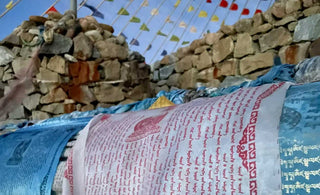
Introduction
In the intricate tapestry of Tibetan culture, Prayer Flags unfold as vibrant symbols deeply rooted in the religious traditions of Bon. Originating from the spiritual landscape of Bon, these flags have transcended their sacred origins, becoming an embodiment of tradition and a canvas for artistic expression. This exploration delves into the rich history of Prayer Flags, tracing their roots to the Bon religion and examining their contemporary significance as a cultural phenomenon.
The Spiritual Origins in Bon Tradition
Prayer Flags find their genesis in the ancient religious practices of Bon, a spiritual tradition that predates Buddhism in Tibet. The Bon religion, characterized by its reverence for nature and the elements, incorporates rituals and ceremonies aimed at maintaining harmony with the cosmos. Prayer Flags were conceived as a tangible form of prayer, with each flag carrying sacred symbols, mantras, and prayers.
These flags were believed to harness the power of the wind, carrying the prayers inscribed on them to the heavens. The colors of the flags held significance, representing the five elements—earth, water, fire, air, and space. The act of hanging Prayer Flags was not merely a cultural custom but a deeply spiritual practice, connecting individuals with the divine forces and fostering a sense of well-being within the community.
As time unfolded, Prayer Flags underwent a transformation, transcending their religious origins to become a visible and cherished aspect of Tibetan culture. The intricate artistry and vibrant hues of the flags caught the eye of artists, designers, and enthusiasts, sparking a movement that saw these sacred emblems making their mark beyond the spiritual realm.
Integration into Modern Aesthetics
Much like the Tibetan Chalcedony Dzi Bead Mystery Bracelet, Prayer Flags have seamlessly integrated into contemporary fashion, representing a harmonious fusion of tradition and modernity. Designers globally have embraced the symbolism and visual appeal of Prayer Flags, incorporating their motifs into clothing, accessories, and even home decor.
The fusion of traditional elements with modern aesthetics has given rise to a unique style that pays homage to the cultural roots of Prayer Flags while catering to the tastes of a global audience. Runways in major fashion capitals now showcase garments adorned with Prayer Flag-inspired patterns, creating a visual dialogue between ancient spirituality and contemporary design.
The appeal of Prayer Flags extends far beyond the Himalayan peaks where they originated. The symbols and colors that once adorned mountain passes are now embraced by people worldwide, transcending cultural boundaries. In a world that often seems divided, Prayer Flags stand as a unifying symbol, reminding us of our shared humanity and interconnectedness.
Natural Materials: A Testament to Tradition and Sustainability
At the heart of the eco-friendly nature of prayer flags lies the choice of materials. Traditionally crafted from natural materials such as cotton, linen, or silk, these flags embody a deep connection to the environment. The conscious selection of materials not only reflects the resourcefulness of Tibetan artisans but also underscores a commitment to sustainability. In an era where synthetic materials dominate, prayer flags stand as a reminder of the beauty and sustainability inherent in nature's offerings.
Prayer flags, with their delicate yet durable composition, epitomize the concept of biodegradability. As they flutter in the wind, gradually weathering and fading, they leave behind no ecological footprint. Unlike modern materials that persist in landfills for centuries, the natural fibers of prayer flags return to the earth in a harmonious cycle. This ephemeral nature aligns with the principles of ecological balance and reminds us of the impermanence of all things: a lesson echoed in Tibetan Buddhist philosophy.
Sustainable Symbolism in Modern Context
In an age where environmental consciousness is at the forefront of global concerns, the eco-friendly nature of prayer flags resonates profoundly. The flags transcend their cultural roots to become symbols of sustainable living, urging individuals to consider the environmental impact of their choices. Embracing prayer flags becomes not just an appreciation of tradition but an affirmation of a lifestyle aligned with nature, promoting the use of sustainable materials in a world increasingly aware of its ecological footprint.
Prayer Flags as Advocates for Eco-Conscious Living
As prayer flags find their way into contemporary expressions such as fashion, art, and home décor, they bring with them a subtle yet powerful message of eco-conscious living. Designers and artists, inspired by the environmentally friendly ethos of the flags, incorporate sustainable practices into their work. The flags become ambassadors for a broader movement towards responsible consumption, encouraging individuals to make choices that honor the planet and its resources.
The eco-friendly nature of prayer flags not only preserves the traditional craft but also positions it as a relevant and vital cultural icon in the 21st century. In a world grappling with environmental challenges, the humble prayer flag emerges as a symbol of hope and responsibility. Its adaptability to contemporary sustainability narratives ensures that the ancient tradition continues to thrive, offering not just spiritual solace but also a lesson in living in harmony with the Earth.
Conclusion
In conclusion, Prayer Flags, rooted in the religious tradition of Bon, have evolved into a cultural phenomenon that transcends borders and resonates with people across the globe. Their journey from sacred rituals to the realms of contemporary fashion and environmental consciousness reflects a dynamic interplay between tradition and modernity. In the grand tapestry of human culture, Prayer Flags continue to flutter, carrying prayers and bridging the spiritual and the secular in a celebration of shared heritage and interconnectedness.























